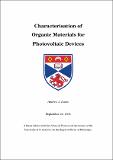Files in this item
Characterisation of organic materials for photovoltaic devices
Item metadata
| dc.contributor.advisor | Samuel, Ifor D. W. | |
| dc.contributor.author | Lewis, Andrew J. | |
| dc.coverage.spatial | xix, 201 leaves | en |
| dc.date.accessioned | 2006-11-21T19:12:53Z | |
| dc.date.available | 2006-11-21T19:12:53Z | |
| dc.date.issued | 2006-09-20 | |
| dc.identifier.uri | https://hdl.handle.net/10023/144 | |
| dc.description.abstract | This thesis presents an investigation into a wide range of potential materials for organic photovoltaic (PV) devices. A variety of optical techniques are used to define physical parameters for each material such as the photoluminescence quantum yield (PLQY), absorption coefficient and exciton diffusion length. Electrical characterisation is used to determine the optimal structure for devices fabricated with these materials. A number of novel materials are presented in this thesis. These include new polymers, both soluble and precursor, and a relatively new class of material, the conjugated dendrimer. These are highly configurable branching molecular structures that enable fine tuning of material properties. Work on polymers presented in this thesis investigates how such materials can be improved by testing the effect of small changes to their molecular structure. One of these changes had significant effects upon the overall material characteristics. The introduction of a dipole across a polymer successfully created a charge separating material without the need for an extra species such as C60 to be present. The introduction of the conjugated dendrimer to PV applications allows significant scope for molecular engineering. Dendrimers enable tight control over certain aspects of the molecular properties. Small changes can be made such as colour tuning or solubility that enable optimisation to be performed on the molecular level, rather than on device structure. Such changes produced significantly higher internal quantum efficiencies (> 90%) than typical polymer devices and offer the prospect of power conversion efficiencies in excess of 10%. Time-resolved luminescence (TRL) spectroscopy was used to characterise the behaviour of photogenerated excitons within organic films. The investigation of exciton diffusion length was performed upon two polymers, each utilising two different time-resolved methods; diffusion to a quencher and exciton-exciton annihilation. It was found that diffusion in polythiophene films is anisotropic and the photoluminescence lifetime is dependent upon film thickness. This is explained by the formation of self-ordered microstructures during the spin coating process. Data modelling was performed which took into account both the thickness variation and the interaction of excitons with a quenching interface producing a much more realistic approach than previously published work. | en |
| dc.format.extent | 5203575 bytes | |
| dc.format.mimetype | application/pdf | |
| dc.language.iso | en | en |
| dc.publisher | University of St Andrews | |
| dc.rights | Creative Commons Attribution-NonCommercial-NoDerivs 2.5 Generic | |
| dc.rights.uri | http://creativecommons.org/licenses/by-nc-nd/2.5/ | |
| dc.subject | Organic photovoltaic (PV) devices | en |
| dc.subject | Polymers | en |
| dc.subject | Dendrimers | en |
| dc.subject.lcc | TK8322.L4 | |
| dc.subject.lcsh | Photovoltaic cells--Materials | |
| dc.subject.lcsh | Organic compounds | |
| dc.subject.lcsh | Polymers--Electric properties | |
| dc.subject.lcsh | Dendrimers--Electric properties | |
| dc.title | Characterisation of organic materials for photovoltaic devices | en |
| dc.type | Thesis | en |
| dc.type.qualificationlevel | Doctoral | en |
| dc.type.qualificationname | PhD Doctor of Philosophy | en |
| dc.publisher.institution | The University of St Andrews | en |
This item appears in the following Collection(s)
Except where otherwise noted within the work, this item's licence for re-use is described as Creative Commons Attribution-NonCommercial-NoDerivs 2.5 Generic
Items in the St Andrews Research Repository are protected by copyright, with all rights reserved, unless otherwise indicated.


